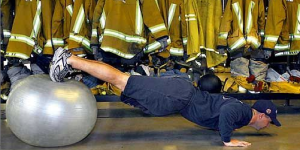By Sara Jahnke
As a scientist who focuses on firefighter health and spends a lot of time collecting data in firehouses around the country, I often am asked what the data says about one health issue or another.
One of the common questions is about exercising on duty.
Sometimes it is the chiefs saying their risk-management team is concerned about the rates of line-of-duty injury (LODI) from exercise — or that they are receiving push back from the community about firefighters “wasting taxpayer money” by spending their time in the gym.
This has led them to ask whether exercise should be encouraged — or even allowed — on duty. This is where the data comes in.
Survey says
Studies are consistently finding that working out while on duty is the leading cause of LODI for firefighters. However, just stopping at the rate of injury from exercise only tells part of the story.
In a FEMA-funded study, we studied risk for injury among firefighters using a sample from the Midwest. Using surveys and asking about health practices and injuries over the last year, we were able to look at the relationship between on-duty exercise and LODI.
The participants were 462 career firefighters from 11 randomly selected fire departments.
We did find that exercise injuries accounted for about a third of on-duty injuries — a rate similar to what other scientists have found. But the data tells us more.
Cause and severity
First, most of the injuries that resulted from exercise were minor strains or sprains. Second, the majority of the injuries did not lead to lost days from work or extended absences. Finally, and maybe most importantly, those who exercised on duty most days were half as likely as their peers to have a non-exercise injury.
So, while on-duty exercise can lead to minor injuries, it is extremely protective against more catastrophic injuries on the fireground or during other duty activities.
Another unexpected note from the findings was the number of injuries that occurred during typical duty activities — often during truck checks.
It is interesting that, while something as basic as a truck check leads to injuries, I have yet to have anyone argue that truck checks shouldn’t occur due to the risk. Obviously, it’s important to know that a truck is well equipped and prepared to go at a moments’ notice.
It seems obvious that it’s equally — if not more important — to have the men and women getting on the truck just as prepared.
Doing it right
The risks of exercise injuries does bring up the importance of proper training and safe exercise which should be an important focus of any firefighter’s fitness routine.
Doing exercise with poor form, more weight, or more intensity than one can handle can be a dangerous practice. While it is important firefighters push themselves to see improvements, it’s equally important they know their limits and exercise in a smart and thoughtful way.
Effective exercise should focus on fitness across domains — strength, flexibility, endurance, mobility, stability and agility — rather than any one alone. Exercise, like firefighting, should require firefighters to be ready for anything.
An article by Dr. Mark Abel published by the National Strength and Conditioning Association outlined a number of suggestions for effective firefighter fitness programs.
Based on the literature, his suggestions include that departments provide supervision and training for firefighters, training take place during times of the day with lower call volume when possible, exercise be intense enough to create positive adaptive changes but not to the point of exhaustion, and firefighters should maintain proper hydration.
Functional fitness
Common threads seem to underlie the effective fitness programs I’ve observed or participated in through the course of our data collection with firefighters from Maine to Guam.
Most focus on functional fitness where activities mirror what firefighters might be tasked with doing on the fireground whether that is lifting and carrying items or running up stairs — activities that engage the whole body.
Exercise also seems to be more effective when crews are working out together. It keeps people motivated and can create friendly competition. Another benefit can be that firefighters critique each other on form and keep each other on task for completing exercises properly.
All in all, while injury is admittedly a risk of on-duty exercise, the data is clear — the overall benefits far outweigh the risks for the firefighters, departments, community and even risk management.
Strong programs can benefit not only firefighters’ individual health parameters, but reduce the departments’ overall risk of LODI on the fireground.
About the author
Sara A. Jahnke, Ph.D. is the director of the Center for Fire, Rescue and EMS Health Research at the National Development and Research Institutes Inc. Dr. Jahnke has served as the principal investigator of two large-scale studies of the health and readiness of the U.S. fire service funded by the Department of Homeland Security and a qualitative study of health and wellness with a national sample of fire service representatives from the American Heart Association. She serves as the principal investigator of a study on the health of women firefighters. She also serves as a co-investigator of several studies focused on fitness, nutrition and health behaviors in both firefighters and military populations. She completed her doctorate in psychology with a health emphasis at the University of Missouri – Kansas City and the American Heart Associations’ Fellowship on the Epidemiology and Prevention of Cardiovascular Disease.
Study measures firefighters’ racing heart rates
University of Texas Study Says Too Many Firefighters Are Overweight.
Effect of Hydration on Whole-Blood Viscosity in Firefighters
CDC – Preventing Chronic Disease
